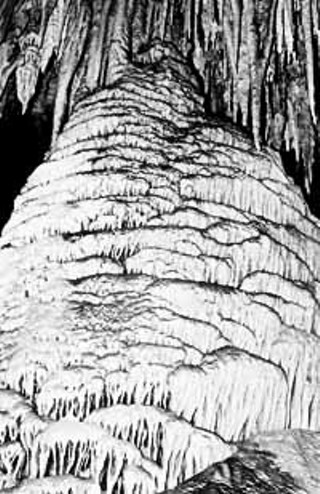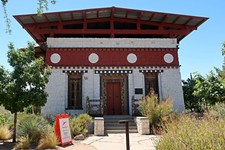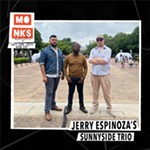Day Trips
The subterranean magnificence of Carlsbad Caverns
By Gerald E. McLeod, Fri., Aug. 10, 2001

Carlsbad Caverns in southern New Mexico is truly one of the most amazing natural wonders of the world. The unusual shapes and creations appear to be the work of a sculptor with an eye for beauty and a tormented soul.
In the Big Room, more than 750 feet below the visitor center, columns that look like they are made of melted wax appear to be holding up the rock ceiling hundreds of feet above your head. White rock soda straws dangle from ledges like pencil-thin pipes of an organ. Paper-thin formations looking like the folds of drapery adorn the walls. The lighting along the path is just enough to guide the explorer and add a subtle dramatic effect to the natural decorations around every bend in the path.
It is amazing to think that the massive columns and the hundreds of stalactites hanging from the ceiling like icicles were created one drip at a time over more than 500,000 years. In some places stalactites reach toward the stalagmites growing from the cave floor like two fingers failing to make the final stretch of a couple of inches to meet. In other places shiny, white crystal formations tucked into an alcove look like fairy lands built by unseen elves.
Part of the Guadalupe Mountains, a southern extension of the Rocky Mountains, the area of the cave started as a reef in an ancient inland sea. The expanse of the ocean floor comes into view from the mountain entrance to the cave.
A cowpoke from Mason County, Texas, discovered the cave entrance in 1898. At first, he thought the swarm of bats filling the evening sky was smoke rising from a volcano. James L. White would spend the next 48 years of his life exploring and working at the cave.
The first commercial exploitation of the cave was mining for bat guano. Tons of the smelly material was lifted out and shipped around the country for use as fertilizer. After 20 years and several owners, the operation shut down. White stayed on at the cave as watchman.
For years White couldn't convince anyone of the beauty and uniqueness of the cave. Once he talked 13 residents of Carlsbad to accompany him into the caverns in 1918 with a photographer, it became a popular tourist destination. At first he led tours down a difficult path through the natural entrance, and then he used the old guano bucket as an elevator to drop visitors into the cave two at a time. A replica of the bucket-lift stands in front of the restaurant in White's City near the entrance to the national park.
Word of the wondrous cave began drifting back to Washington and New York. Newspapers sent reporters, and after an extensive investigation President Calvin Coolidge proclaimed the site as Carlsbad Cave National Monument in 1923, only 11 years after New Mexico become a state.
With federal support, a superintendent arrived and improvements began opening the cave to visitors and exploration. The guano bucket was replaced with a wooden staircase through the natural entrance. In 1930, Congress added the cave to the National Park Service. A year later, the first elevator shaft was completed from the visitor center to the Big Room.
Over the years the cave has changed little, but a great many things have been discovered. The visitors' impact on the fragile environment has been studied and minimized. What started as a park on little less than 1,000 acres of state land now encompasses more than 46,000 acres of wilderness area and 80 cave systems.
About 26 miles south of Carlsbad off of U.S. 62, the cave entrance can be reached from Austin in a nine-hour drive. With the time change, it is possible to leave Austin at 7am and be at the visitor center by 3pm with plenty of time to tour the Big Room, have supper, and return to the cave for the bat emergence at sunset.
The Big Room is the largest cave room in the U.S., covering 57 acres. The mile-long path meanders around the perimeter of the room past some of the most recognizable formations in the caverns. It takes about an hour to complete the tour from the underground snack bar. Most of the path is an easy hike and wheelchair-accessible, but there is a portion near the end where a steep climb is not open to wheelchairs.
The Natural Entrance Route adds another hour to the tour and goes past several unique formations. The path follows much of the same path that Jim White followed when he discovered the cave. This self-guided tour is recommended for visitors in good health.
Ranger-guided tours of the King's Palace are scheduled throughout the day, with the last one starting around 3:15pm. Special guided tours to other parts of the park and cavern are occasionally offered. Check at the information center for what is available. The visitor center also houses a kennel, gift shop, and restaurant.
There are accommodations in White's City, but prices tend to be much higher than in Carlsbad. The restaurant we tried near the entrance to the park was extremely expensive and of poor quality. There is a historic hotel operated by Best Western and a modern hotel with a water park nearby. Hotel accommodations in Carlsbad are more affordable, but fill quickly on weekends.
The Mexican free-tail bats leave the cave around sunset, April though October, with the largest number after the babies are weaned in late July. A ranger gives a short talk about the bats leading up to the emergence.
Carlsbad Caverns is open year-round except Christmas Day. For information, call the park at 505/887-2232 or visit www.nps.gov/cave. The temperature in the cave is a damp 56 degrees making a light jacket nice, but not a necessity. Wear good walking shoes with a non-slip sole, and a small flashlight comes in handy.
Coming up ...
The EmilyAnn Theater just north of the Wimberley High School off RR 2325 presents A Comedy of Errors Aug. 10, 14, 16, and 18; A Macbeth will be preformed by local students on Aug. 11, 13, 15, and 17. 512/847-6969 or www.emilyann.org.








